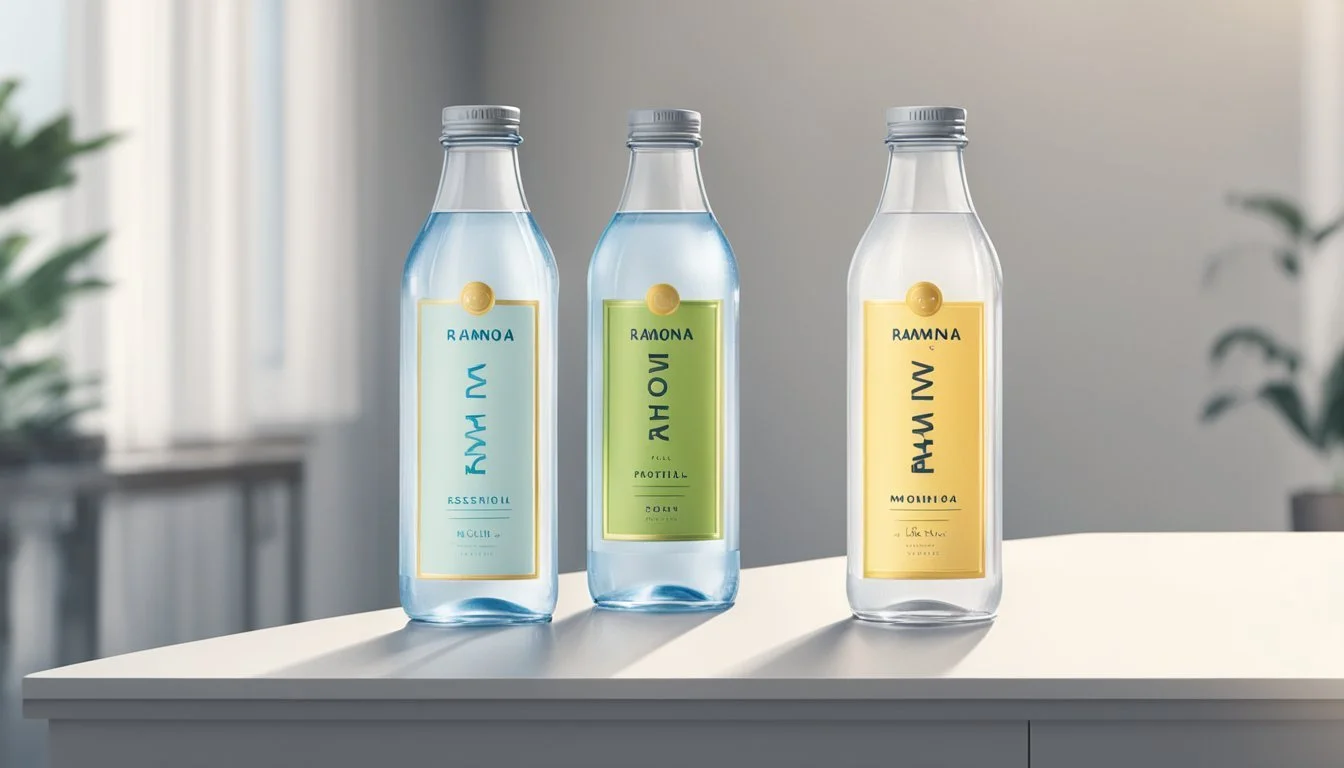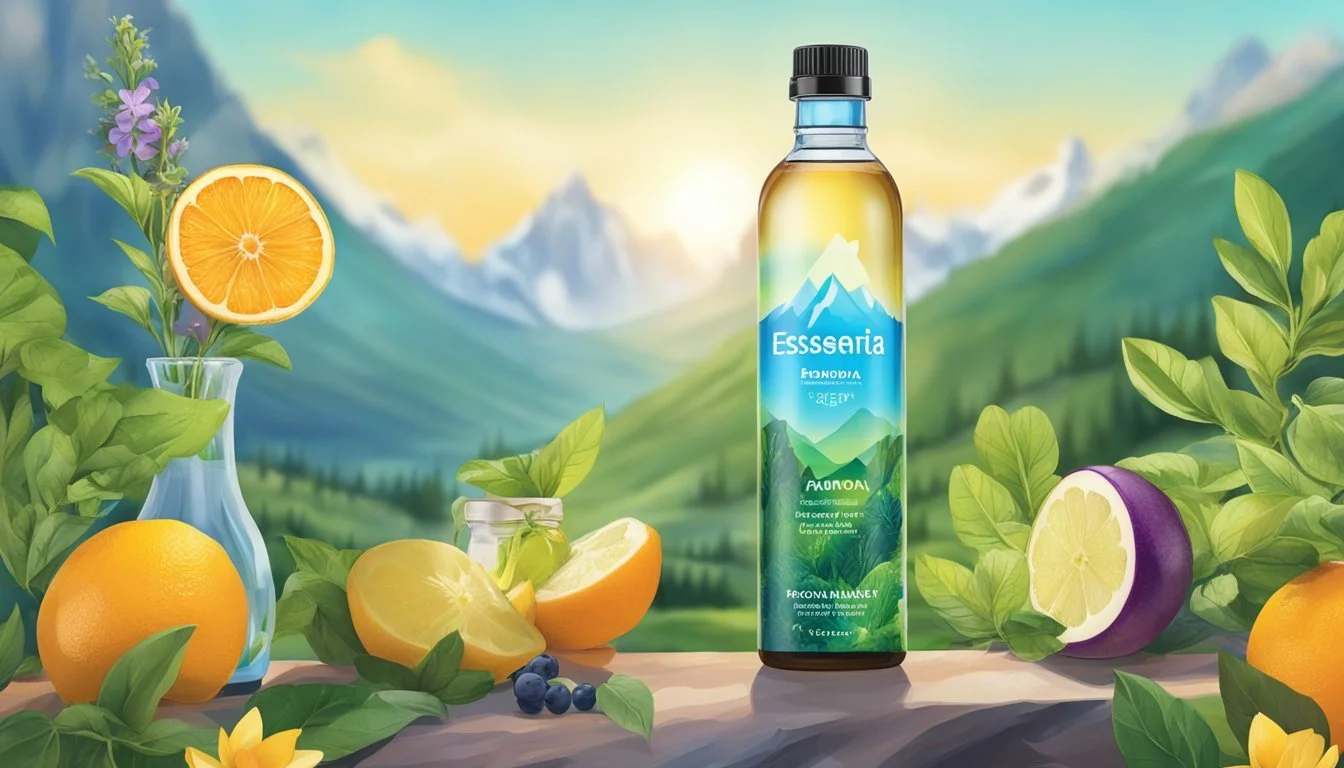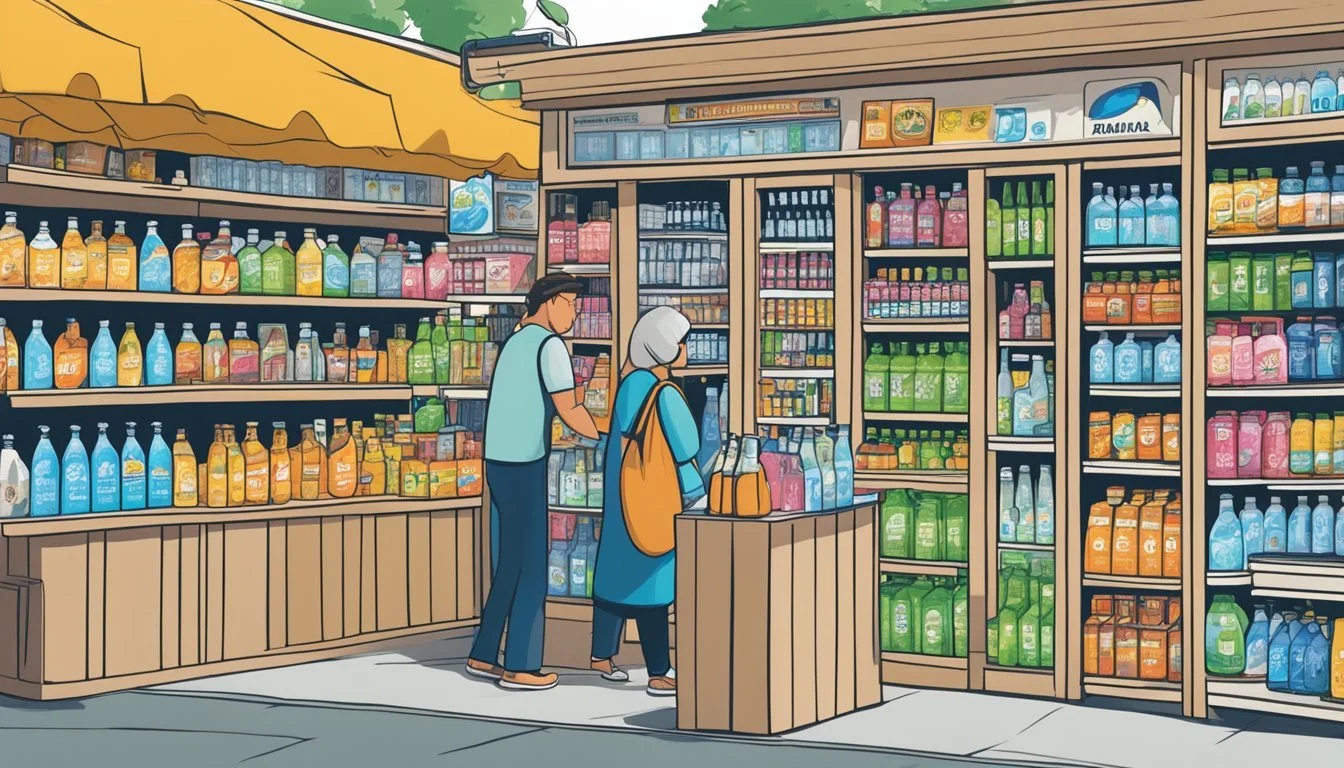Essentia vs. Ramona
Comparing the Best Bottled Waters
Choosing the right bottled water can seem trivial, but with so many brands on the market, it can make a significant difference in your hydration experience. Essentia, known for its exceptionally high pH of 9.5, offers a clean and smooth taste, making it popular among those who prefer alkaline water. Ramona, though less known, prides itself on a crisp and refreshing flavor that comes from its pristine natural sources.
For those who prioritize alkalinity and a silky texture, Essentia stands out as the preferred choice. Its dedication to purity ensures a nearly zero acidity level, appealing to individuals looking for balance and hydration efficiency. On the other hand, Ramona's naturally sourced water offers a strikingly refreshing taste, which can be a deciding factor for many.
In the debate of Essentia vs. Ramona, it ultimately comes down to personal preference. If high pH and smooth finish are what you seek, Essentia should be your go-to. For those who appreciate a crisp, natural flavor, Ramona delivers a satisfying experience without compromise.
Understanding Bottled Water
Choosing the best bottled water involves understanding various types, label claims, and the regulatory standards that govern the industry.
Types of Bottled Water
Bottled water comes in several varieties, each with distinct characteristics.
Spring Water: Sourced from natural springs, it retains minerals, giving it a natural taste.
Mineral Water: Contains natural minerals, often from underground sources, and must maintain specific mineral levels.
Purified Water: Undergoes processes like distillation, deionization, or reverse osmosis to remove impurities, offering high purity.
Alkaline Water: Known for a higher pH level, it is often ionized and infused with electrolytes.
Ionized Water: Typically made alkaline through ionization, it's believed to offer better hydration.
Label Claims and Meanings
Navigating label claims can be confusing. Here’s a breakdown of common terms:
pH Level: Indicates the acidity or alkalinity. Alkaline waters usually have a pH above 7.
Electrolytes: Added to improve taste and hydration. Commonly found in sports and hydration-focused brands.
Purity: Stated percentages or terms like "99.9% pure" reveal the extent of filtration.
Natural: Often used to imply minimal processing. Always verify sources.
Infused: Usually indicates added minerals or electrolytes. Check for specifics on content.
Regulatory Standards
Bottled water is governed by stringent standards in many countries.
FDA (United States): Ensures bottled water meets safety and labeling requirements. Comparatively, these must be as stringent as the EPA's tap water regulations.
EFSA (Europe): Oversees safety and quality, focusing on contamination prevention and maintaining accurate labeling.
International Bottled Water Association (IBWA): Offers additional guidelines and certifications, ensuring members adhere to high production standards.
Tests and Certification: Products often undergo regular testing for contaminants, pH levels, and total dissolved solids (TDS).
Understanding these key points helps consumers make informed choices about the bottled water they select.
Source and Purification
Essentia and Ramona take different approaches in sourcing and purifying their bottled water, which impacts the taste, purity, and health benefits.
Essentia Water Source and Purification
Essentia sources its water from various municipal supplies across the United States.
The water undergoes microfiltration, reverse osmosis, and ultraviolet exposure. This multi-step process ensures 99.9% purity by removing contaminants, bacteria, and other impurities.
Electrolytes, including calcium, magnesium, and potassium, are then added to enhance taste and health benefits. Finally, the water is ionized to achieve a high alkaline pH of 9.5 or higher. This high pH level is meant to aid in better hydration and balance the body's pH levels.
Ramona Water Source and Purification
Ramona sources its water from natural springs located in pristine, environmentally-protected areas.
The spring water undergoes a more minimal purification process compared to Essentia. Standard procedures include filtration to eliminate large particles and basic UV treatment for biological contaminants.
Since the water is sourced from springs, it naturally contains minerals and electrolytes, often preferred for their natural taste and potential health benefits. No ionization process is involved, and the pH levels remain natural, which usually range from slightly acidic to neutral.
Comparison of Purification Processes
Essentia employs a rigorous purification process involving reverse osmosis, microfiltration, and UV exposure, leading to highly purified water. Electrolytes infusion and ionization are additional steps to improve hydration and pH balance.
Ramona's purification is simpler, focusing on maintaining the natural composition of spring water. The primary methods are filtration and UV treatment, which preserve the water's natural minerals and electrolytes.
Process Essentia Ramona Source Municipal supplies Natural springs Purification Microfiltration, Reverse Osmosis, UV exposure Basic filtration, UV treatment Minerals Added Electrolytes added post-purification Naturally occurring minerals pH Level High alkaline, pH 9.5 or higher Natural, slightly acidic to neutral
Essentia's more complex process ensures a high purity level, while Ramona retains its natural mineral content and taste.
Composition and Health Benefits
Essentia and Ramona offer distinct features in their compositions and purported health benefits. Key areas of interest include their pH levels, mineral content, and hydration efficacy, especially in relation to fitness.
pH Levels and Its Effects
Essentia water boasts a pH level of 9.5, classifying it as ionized alkaline water. This elevated pH is achieved through a proprietary ionization process. Alkaline water is known for its potential to neutralize stomach acidity and aid in reducing acid reflux.
Ramona's water, typically falling in the neutral pH range of 7, suits those who prefer water without the distinctive taste that can come from higher pH levels. While the benefits of alkaline water are still debated, it is popular among consumers seeking to balance body acidity.
Essential Minerals and Electrolytes
Essentia water contains a unique blend of essential minerals and electrolytes such as magnesium, potassium, and calcium, added during the ionization process. These minerals are crucial for various bodily functions including muscle and nerve operation.
Ramona water, on the other hand, is sourced naturally and may contain varying levels of minerals based on its source. Essential minerals in Ramona water typically include calcium and magnesium, which are important for bone health and metabolic function.
Hydration and Fitness
For athletes and fitness enthusiasts, hydration is key. Essentia claims that its ionized alkaline water provides superior hydration due to its high pH and concentration of electrolytes, which can help maintain electrolyte balance during intense physical activity.
Ramona, with its natural mineral content, also supports hydration. The presence of total dissolved solids (TDS) in Ramona water can aid in replenishing the body’s needs after exercise. While both brands offer hydration benefits, preferences may vary depending on individual fitness and hydration needs.
Taste Evaluation
Both Essentia and Ramona offer unique taste profiles that cater to different preferences. The key aspects include smoothness, aftertaste, and overall water taste.
Taste Profile of Essentia
Essentia Water is known for its clean and crisp taste. The ionization process and added electrolytes give it a distinctive smoothness. This process ensures that the water is free from impurities, contributing to its refreshing taste without any unpleasant aftertaste.
The pH level, at 9.5, makes the water alkaline, which some find to taste slightly different from neutral pH water. The electrolytes not only enhance hydration but also add a subtle flavor. Many consumers report a slight tang, which is often appreciated by those who prefer a more robust water taste.
Taste Profile of Ramona
Ramona Water is naturally-sourced and minimally processed, retaining some of the natural minerals. This results in a more natural and less processed taste compared to Essentia. The water is smooth and soft, with a hint of mineral flavor that can be refreshing.
It has a neutral pH, making it comparable to pure spring water. There is usually no noticeable aftertaste, which can be appealing for those who prefer their water to be as tasteless and pure as possible. The balance of natural minerals contributes to its overall pleasant and mild flavor.
Taste Preferences and Influencing Factors
Consumer preferences for bottled water taste can vary widely. Some people prefer the clean and enhanced taste of Essentia, especially those who value the added electrolytes and higher pH.
Others might lean towards Ramona for its natural and unaltered flavor. Factors such as smoothness, aftertaste, and mineral content play a significant role. Those sensitive to slight aftertaste nuances might favor Ramona, whereas individuals who appreciate a distinct and tangy flavor could prefer Essentia.
Preferences are also influenced by marketing, brand loyalty, and previous experiences with the water. Understanding these taste profiles and factors aids consumers in making informed choices based on their specific taste preferences.
Packaging and Environmental Considerations
When evaluating Essentia and Ramona, factors like bottle materials, BPA content, eco-friendly packaging options, and sustainability practices play a crucial role.
Bottle Materials and BPA Content
Essentia primarily uses plastic bottles made from polyethylene terephthalate (PET). This material is chosen for its durability and lightweight properties. Some concerns exist around the possible presence of bisphenol A (BPA) in plastic bottles, though Essentia claims their products are BPA-free, enhancing consumer confidence in the safety of their packaging.
Ramona, on the other hand, opts for glass bottles. Glass is known for its purity and does not leach chemicals into the water, addressing any BPA concerns naturally. This choice may appeal to those who are highly cautious about chemical exposure from packaging.
Eco-Friendly Packing Options
Essentia has introduced CarbonNeutral® packaging, a step towards reducing its environmental impact. This certification signifies that Essentia offsets carbon emissions associated with its bottle production, aligning with sustainable practices.
Ramona's use of glass bottles is inherently more eco-friendly compared to plastic. Glass is endlessly recyclable and can be reused without losing quality. This reduces the overall environmental footprint significantly, making it a strong contender for eco-conscious consumers.
Sustainability Practices
Essentia's sustainability initiatives include efforts to reduce their carbon footprint and increase recycling awareness. Their wide distribution network also emphasizes efficient logistics to minimize transportation emissions.
Ramona emphasizes sustainable practices through its commitment to using glass bottles—reducing plastic waste in landfills and oceans. Additionally, Ramona invests in renewable energy sources for its production facilities, further showcasing its dedication to environmental stewardship.
Market Presence and Consumer Perception
Essentia and Ramona are both prominent brands in the bottled water market. This section explores their brand reputation, consumer reviews, and visibility in retail and online spaces to help determine which brand stands out.
Brand Reputation and Recognition
Essentia has established itself as a premium alkaline water brand, emphasizing its alkalinity and ionization process. It's particularly popular among health-conscious consumers seeking water with added benefits. Ramona, while less publicized in terms of health claims, positions itself as a high-quality, refreshing option with natural purity.
Essentia enjoys a well-recognized name due to aggressive marketing efforts and endorsements by athletes and wellness influencers. Ramona tends to leverage its origin story and commitment to sustainability, which resonates with environmentally-conscious consumers. Both brands have loyal followings, yet their reputations cater to slightly different demographics.
Consumer Reviews and Testimonials
Reviews for Essentia often highlight its crisp taste and perceived health benefits, such as hydration efficiency and improved energy levels. On platforms like Amazon, Essentia frequently receives high ratings, with customers praising its consistent quality and alkalinity. Negative reviews occasionally mention a higher price point, yet these critiques are overshadowed by positive feedback.
Ramona garners praise for its refreshing taste and smooth texture. Customers value its affordability compared to other premium water brands. Testimonials often commend Ramona for being a reliable daily drinking water, although some users note that it lacks the specific health claims associated with Essentia. Both brands have strong positive reviews, but Essentia's endorsements emphasize health benefits, whereas Ramona focuses more on taste and value.
Visibility in Retail and Online Spaces
Essentia has a significant presence in both retail and online markets, appearing prominently in grocery stores, health food shops, and e-commerce websites. Its packaging and branding are easily recognizable, aiding in its market penetration. Partnerships with major retailers further enhance its visibility.
Ramona, while also available in many retail locations, has a more modest online presence. It is widely accessible in local markets and some national chains but doesn't command the same shelf space as Essentia. Online, Ramona's availability can vary, affecting its convenience for some consumers. Both brands are visible, but Essentia's broader reach in multiple channels makes it more readily available for a wider audience.
Cost Comparison
Essentia and Ramona come with various pricing structures influenced by multiple factors. This section delves into the costs associated with each brand and evaluates their overall value.
Pricing of Essentia and Ramona
Essentia typically sells at a premium price point due to its ionization process and higher pH levels. A 12-pack of 1-liter bottles can range between $18 to $25.
Ramona, being a newer brand, usually offers slightly lower prices to attract customers. A similar pack of Ramona bottles often costs between $15 to $21.
Both brands are widely available in supermarkets and online, but prices may vary based on location and retailer.
Factors Affecting Price
Several factors contribute to the pricing of Essentia and Ramona bottled water:
Production Process: Essentia’s ionization and alkaline enhancement technology add to production costs. Ramona’s unique, locally-sourced spring water processes also impact its pricing.
Packaging: Essentia invests in eco-friendly packaging, which might raise costs. Ramona focuses on minimalist designs which might be slightly cheaper.
Distribution and Availability: Widely available brands may have stable prices, while niche markets could see higher costs due to less distribution.
Comparing Value for Money
Essentia offers excellent hydration benefits and higher pH levels, which appeal to health-conscious consumers. Many buyers are willing to pay a higher price for these benefits.
Ramona provides quality spring water at a slightly lower price. Its competitive pricing strategy aims to offer good value for money without compromising on quality.
When considered alongside customer perception, Essentia’s established reputation often justifies its premium pricing, while Ramona’s affordability appeals to a broader range of consumers seeking cost-effective options.
Essentia is best for those prioritizing advanced water processing and health benefits.
Ramona is ideal for those who want quality spring water at a lower price point.
Final Verdict
When comparing Essentia and Ramona, several factors come into play.
Essentia Water:
Type: Alkaline
pH Level: 9.5 or higher
Process: Micro-filters, reverse osmosis, ultraviolet exposure, ionization
Benefits: Claims better hydration and higher pH for optimal bodily function
Essentia is lauded for its rigorous purification and ionization processes. These result in water that is 99.9% pure and enhanced with electrolytes. The high pH level is intended to provide better hydration and balance body acidity.
Ramona Water:
Type: Purified
pH Level: Neutral to slightly alkaline
Process: Standard purification methods, possibly less information on advanced ionization
Benefits: Reliable, basic hydration needs
Ramona offers purified water, catering to those who prefer a straightforward approach to hydration. It typically lacks the extensive ionization process found in Essentia, which may affect its appeal to those seeking specific health benefits.
Comparison Table:
Feature Essentia Ramona Type Alkaline Purified pH Level 9.5+ Neutral-Alkaline Purification Process Micro-filters, RO, UV, Ionized Standard Key Benefits Better hydration, Electrolytes Basic hydration
For users seeking advanced purification and a higher pH level for potential health benefits, Essentia stands out. For those who prefer simplicity and reliable purification, Ramona remains a solid choice.
More About Essentia
Essentia vs Cascade Mountain: Which Bottled Water is Better?
Essentia vs Hawaiian Springs: Which Bottled Water is Better?
Essentia vs Icelandic Glacial: Which Bottled Water is Better?
Essentia vs Kirkland Signature: Which Bottled Water is Better?
Essentia vs Mountain Valley Spring Water: Which Bottled Water is Better?
Essentia vs Nestle Pure Life: Which Bottled Water is Better?
Essentia vs Richard's Rainwater: Which Bottled Water is Better?
Essentia vs Talking Rain AQA: Which Bottled Water is Better?
Essentia vs Whole Foods Italian Still Mineral water: Which Bottled Water is Better?








